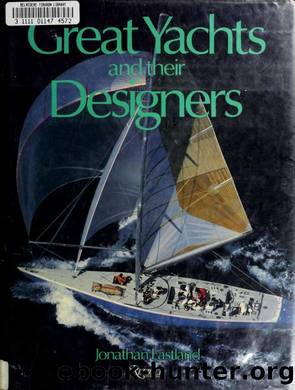Great yachts and their designers by Eastland Jonathan

Author:Eastland, Jonathan
Language: eng
Format: epub, pdf
Tags: Yachts, Yachts, Yacht designers
Publisher: New York : Rizzoli
Published: 1987-10-15T00:00:00+00:00
Right: Lionheart. Following pages: Sverige (left), designed by Sweden's Pelle Petterson, racing with Constellation, the 1964 Stephens-designed defender, off Brighton, England, in 1979.
the finals. Bond returned home again; lesser men would have crawled into a hole to hide.
Alan Bond may have received another knockdown, but he certainly wasn't beaten or out of the running. His real-estate business had benefited not a little from his involvement in the cup, and in 1980 he again channeled his efforts for another crack at the event. Ben Lexcen, always confident that the hand-me-down rig from Southern Cross had been Australia's undoing in 1977, was asked by Bond to make modifications to the boat rather than design a new one.
In England, Tony Boyden was mounting a challenge with a Howlett-designed twelve called Lionheart. This effort was to be beset with managerial problems, but for all that, Lionheart had potential. In her many trial outings in the Solent during the early summer of 1980, the first British twelve for many years sported an unusual, bendy mast, a rule-cheater that allowed several hundred extra square feet of canvas to be hoisted, giving the yacht better speed than her opponents in light airs.
The American defenders were skeptical of this asset, probably because there was too little time for them to develop their own bendy rig. But Lexcen was quick to see the potential advantages and soon had a similar rig hoisted on the modified Australia. A 4-meter-long fiberglass tip was added to a conventional mast, giving not only the extra sail area necessary for extra speed in light weather but also a more efficient masthead from an aeronautical standpoint.
In the elimination rounds, the Lexcen boat knocked out Baron Bich's France III and then almost as easily disposed of the British. The final match, between Dennis Conner's Freedom and Australia, produced a series of races un-equaled for excitement in the previous contemporary history of-the cup. It was at last clearly apparent that someone other than America had an edge; 1980 was the year the myth that American 12-meter crews were unbeatable finally went out the window. Bond and Lexcen came away beaten 4-1, but now they had had the taste of victory. Had time not run out on another race, they would have won that too by a staggering 700-meter lead.
Bond wasted no time in making his challenge for the 1983 event, announcing at the final press conference in the Newport Armory in 1980 that he would be back in 1983 with Ben Lexcen, and with Australia's sail-trimmer, John Bertrand, as skipper of a new boat.
Bertrand and Lexcen had worked together previously on masts for Southern Cross. Now they were to become part of a formidable team in which every Bond-picked member contributed in no small way to the eventual undoing of American domination. Lexcen was given virtual carte blanche to go away and try out anything that took his fancy that he believed might make for a faster, more maneuver-able yacht.
Download
Great yachts and their designers by Eastland Jonathan.pdf
This site does not store any files on its server. We only index and link to content provided by other sites. Please contact the content providers to delete copyright contents if any and email us, we'll remove relevant links or contents immediately.
Great yachts and their designers by Eastland Jonathan(115)
The Art of portraits and the nude by Time-Life Books(84)
softcover by Unknown(60)
Take Great Pictures by Lou Jacobs(48)
Hidden Prairie: Photographing Life in One Square Meter by Chris Helzer(31)
Solving the Problem of Photochemical Kinetics in a Medium with Low Reagent Mobilities by Unknown(31)
FlowBased, Cerium Oxide Enhanced, LowLevel Palladium Sonogashira and Heck Coupling Reactions by Perovskite Catalysts by Unknown(28)
LiBr-catalyzed one-pot three-component domino strategy toward the construction of β-phosphonomalonates scaffolds in aqueous conditions by Kumar Vikas & Kour Parteek & Kumar Anil(26)
A new end-on azido-bridged dicopper(II) complex; syntheses, structure, solvatochromism, magnetic properties, and DFT study by Sara Koohzad & Hamid Golchoubian & Zvonko Jagličić(25)
The Effects of Iron-Mediated Oxidative Stress in Isolated Renal Cortical Brush Border Membrane Vesicles at Normothermic and Hypothermic Temperatures by R. Horton1 2 Catherine Rice-Evans1 & B. J. Fuller2(23)
The English Civil War Recreated in Colour Photographs by Unknown(20)
Canvas Detroit by Julie Pincus and Nichole Christian(19)
